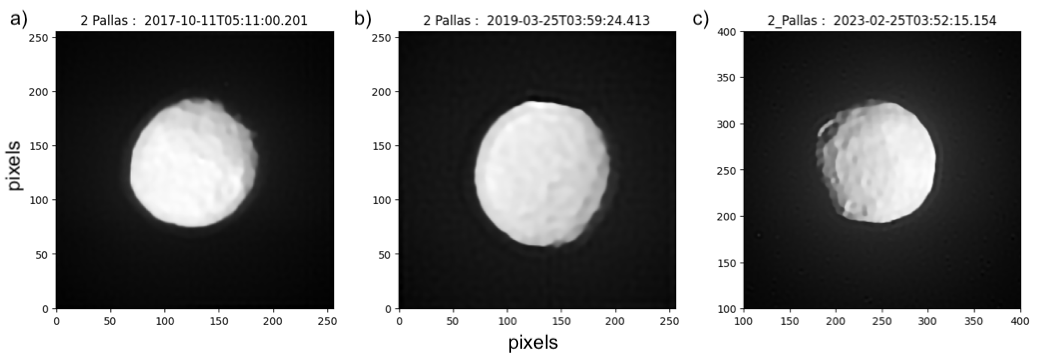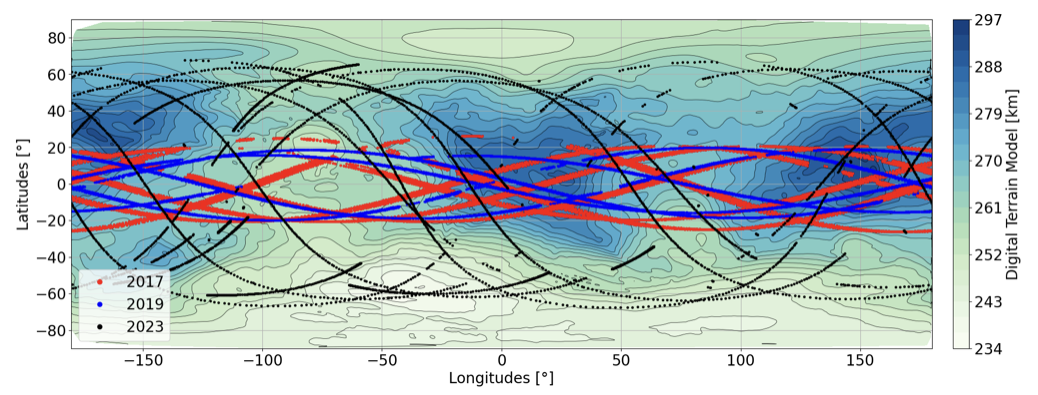Asteroid (2) Pallas: a trip from the limbs profiles to the interior
- 1IMCCE, Observatoire de Paris, Université PSL, Sorbonne Université, CNRS, Paris, France (julie.vermersch@obspm.fr)
- 2European Southern Observatory, Santiago, Chile
1. Introduction
The asteroid (2) Pallas is the largest main-belt object not yet visited by a spacecraft. Its surface geology and internal structure remain poorly constrained. However, by means of adaptive-optics-fed ground-based instrumentation, its three-dimensional shape is now fairly well known with a spatial resolution of about 20km (Fétick et al. 2019). High-angular-resolution observations of Pallas’s north and south poles (Fig. 1, a) south, b) north), provided by ESO/VLT/SPHERE, have been analysed by Marsset et al. (2020). Additionally, in 2023, new adaptive-optics images have been performed under an equator-on geometry (Fig. 1, c)), allowing for a revision of its polar axis and, thus, of its volume and bulk density.

Fig. 1 Deconvolved images of the asteroid (2) Pallas (ESO/VLT/SPHERE) with different observation geometries: a) south pole, b) north pole and c) equator.
2. Method
Based on these two observation sets and the reconstructed shape model, the global shape and topography of Pallas can be described with a spherical harmonics decomposition (e.g. Rambaux et al. 2022). This description allows us to differentiate large spatial structures related to the equilibrium figures (small degree terms) from smaller local structures (high degree terms) that arise due to collisional history.
3. Probation of shape model
The extraction of Pallas limbs, acquired over three different epochs, and their projection on the topographic map highlight their homogenous spatial distribution, almost covering the full surface (Fig. 2). The fine match between the topographic features along the limbs and on the projected shape model reveals the accuracy of the model. In order to assess a confidence interval on the shape measurements, we computed residuals between observed limbs and reconstructed ones in spherical harmonics. Furthermore, to estimate the global shape of Pallas, we used its Digital Terrain Model (Jorda et al. 2016). From the estimation of the degree 2 of the DTM spherical harmonic decomposition, we determined the degree limit of the influence of higher degrees.

Fig. 2 Projection of the observed limbs profiles on topographic surface map, obtained from shape model.
4. Discussion
This shape study will be continued with the determination of an internal structure, exploring a differentiated interior. The important craterisation of the surface, reported by Marsset et al. (2020), will lead to a geological analysis of the crust rheology (Asphaug et al. 1996, Fu et al. 2014, Johnson et al 1973), probing its density, strength and viscosity. Relaxation times needed to reach a near zero shear stress state will be discussed.
References:
Asphaug, E., Moore, J. M., Morrison, D., Benz, W., Nolan, M. C., & Sullivan, R. J. (1996). Mechanical and geological effects of impact cratering on Ida. Icarus, 120(1), 158-184.
Fétick, R. J., Jorda, L., Vernazza, P., Marsset, M., Drouard, A., Fusco, T., ... & Yang, B. (2019). Closing the gap between Earth-based and interplanetary mission observations: Vesta seen by VLT/SPHERE. Astronomy & Astrophysics, 623, A6.
Fu, R. R., Hager, B. H., Ermakov, A. I., & Zuber, M. T. (2014). Efficient early global relaxation of asteroid Vesta. Icarus, 240, 133-145.
Johnson, T. V., & McGetchin, T. R. (1973). Topography on satellite surfaces and the shape of asteroids. Icarus, 18(4), 612-620.
Jorda, L., Gaskell, R., Capanna, C., Hviid, S., Lamy, P., Ďurech, J., ... & Wenzel, K. P. (2016). The global shape, density and rotation of Comet 67P/Churyumov-Gerasimenko from preperihelion Rosetta/OSIRIS observations. Icarus, 277, 257-278.
Marsset, M., Brož, M., Vernazza, P., Drouard, A., Castillo-Rogez, J., Hanuš, J., ... & Yang, B. (2020). The violent collisional history of aqueously evolved (2) Pallas. Nature Astronomy, 4(6), 569-576.
Rambaux, N., Lainey, V., Cooper, N., Auzemery, L., & Zhang, Q. F. (2022). Spherical harmonic decomposition and interpretation of the shapes of the small Saturnian inner moons. Astronomy & Astrophysics, 667, A78.
How to cite: Vermersch, J., Marsset, M., Rambaux, N., and Sicardy, B.: Asteroid (2) Pallas: a trip from the limbs profiles to the interior, Europlanet Science Congress 2024, Berlin, Germany, 8–13 Sep 2024, EPSC2024-614, https://doi.org/10.5194/epsc2024-614, 2024.